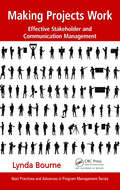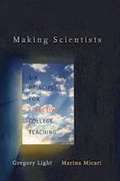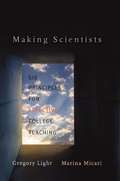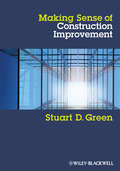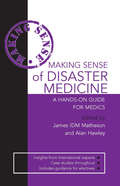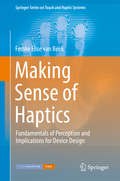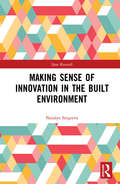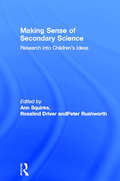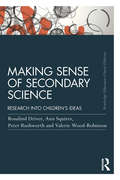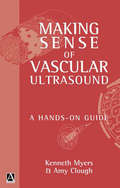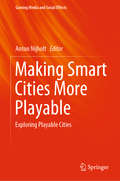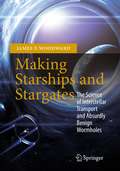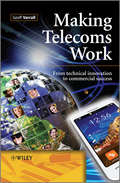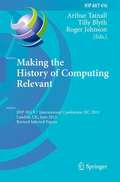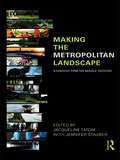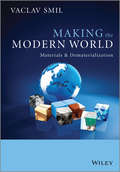- Table View
- List View
Making Projects Work: Effective Stakeholder and Communication Management (Best Practices in Portfolio, Program, and Project Management)
by Lynda BourneThis book provides a framework for understanding and managing factors required for achieving successful project and program outcomes. It presents guidelines to help readers develop an understanding of governance and its connection to strategy as the starting point for decisions on what work needs to be done. The book describes how to craft appropriate communication strategies to develop and maintain successful relationships with stakeholders. It highlights the strengths and weaknesses of existing project controls and outlines effective communication techniques for managing expectations and acquiring the support required for successful delivery.
Making Projects Work: Effective Stakeholder and Communication Management (Best Practices in Portfolio, Program, and Project Management)
by Lynda BourneThis book provides a framework for understanding and managing factors required for achieving successful project and program outcomes. It presents guidelines to help readers develop an understanding of governance and its connection to strategy as the starting point for decisions on what work needs to be done. The book describes how to craft appropriate communication strategies to develop and maintain successful relationships with stakeholders. It highlights the strengths and weaknesses of existing project controls and outlines effective communication techniques for managing expectations and acquiring the support required for successful delivery.
Making Scientists: Six Principles For Effective College Teaching
by Gregory LightGregory Light and Marina Micari reject the view that science, technology, engineering, and mathematics are elite disciplines restricted to a small number with innate talent. Rich in concrete advice, Making Scientists offers a new paradigm of how scientific subjects can be taught at the college level to underrepresented groups.
Making Scientists: Six Principles For Effective College Teaching
by Gregory LightGregory Light and Marina Micari reject the view that science, technology, engineering, and mathematics are elite disciplines restricted to a small number with innate talent. Rich in concrete advice, Making Scientists offers a new paradigm of how scientific subjects can be taught at the college level to underrepresented groups.
Making Sense of Construction Improvement
by Stuart D. GreenThe book sets out deliberately to challenge the current construction improvement debate and the way in which it is conducted. It confronts the supposedly neutral nature of construction 'best practice' and demonstrates that that the advocated recipes seldom stand up to critical scrutiny. It further argues that commonly accepted components of best practice such as lean construction, partnering and collaborative working rarely live up to the claims made on their behalf. Such recipes invariably suffer from definitional vagueness, and are constantly reinterpreted to suit the needs the different audiences. Making Sense of Construction Improvement argues that construction sector improvement techniques cannot be understood in terms of their substantive content, and are best understood in terms of the rhetoric within which they are presented. The author also contends that the persuasiveness of such recipes depends upon the extent to which practitioners can adopt them for the purposes of making sense of the changes they observe happening around them. To be accepted as 'best practice' construction improvement techniques must also resonate with broader agendas of socio-technological change. The author charts how the best practice debate has developed from the aftermath of the Second World War through to the election of David Cameron's coalition government in 2010. Attention is given to the way in which the improvement debate throughout the 1960s and 70s was shaped by the broader aspirations of the post-war social consensus and the associated desire for a centrally planned economy. Attention thereafter is given to the way the construction sector was radically re-shaped by the advent of the enterprise culture. The privatisation of the sector's client base, coupled with the withdrawal of the state as a provider of mass housing, caused a significant and long-lasting shift in the construction landscape. Private sector clients similarly experienced extensive downsizing while outsourcing their procurement capabilities. Such strategies were frequently justified by mobilising the rhetoric of business process re-engineering (BPR). Contracting firms simultaneously faced unpredictable workloads and increasing market competition. In response, the sector at large chose to base their competitive advantage on leanness and agility. Hence the emergence of the hollowed-out firm as the dominant form of organising. These structural trends combined to provide the backcloth to the industry improvement agenda throughout the 1980s and 1990s. Making Sense of Construction Improvement argues that the popularity of improvement recipes such as partnering, collaborative working and integrated teams can be understood as strategies for overcoming the loss of control associated with downsizing and outsourcing. In contrast to other textbooks, Making Sense of Construction Improvement does not offer advice on how to manage construction projects more effectively; the aim is rather to understand the forces which have shaped the construction sector improvement agenda over time.
Making Sense of Construction Improvement
by Stuart D. GreenThe book sets out deliberately to challenge the current construction improvement debate and the way in which it is conducted. It confronts the supposedly neutral nature of construction 'best practice' and demonstrates that that the advocated recipes seldom stand up to critical scrutiny. It further argues that commonly accepted components of best practice such as lean construction, partnering and collaborative working rarely live up to the claims made on their behalf. Such recipes invariably suffer from definitional vagueness, and are constantly reinterpreted to suit the needs the different audiences. Making Sense of Construction Improvement argues that construction sector improvement techniques cannot be understood in terms of their substantive content, and are best understood in terms of the rhetoric within which they are presented. The author also contends that the persuasiveness of such recipes depends upon the extent to which practitioners can adopt them for the purposes of making sense of the changes they observe happening around them. To be accepted as 'best practice' construction improvement techniques must also resonate with broader agendas of socio-technological change. The author charts how the best practice debate has developed from the aftermath of the Second World War through to the election of David Cameron's coalition government in 2010. Attention is given to the way in which the improvement debate throughout the 1960s and 70s was shaped by the broader aspirations of the post-war social consensus and the associated desire for a centrally planned economy. Attention thereafter is given to the way the construction sector was radically re-shaped by the advent of the enterprise culture. The privatisation of the sector's client base, coupled with the withdrawal of the state as a provider of mass housing, caused a significant and long-lasting shift in the construction landscape. Private sector clients similarly experienced extensive downsizing while outsourcing their procurement capabilities. Such strategies were frequently justified by mobilising the rhetoric of business process re-engineering (BPR). Contracting firms simultaneously faced unpredictable workloads and increasing market competition. In response, the sector at large chose to base their competitive advantage on leanness and agility. Hence the emergence of the hollowed-out firm as the dominant form of organising. These structural trends combined to provide the backcloth to the industry improvement agenda throughout the 1980s and 1990s. Making Sense of Construction Improvement argues that the popularity of improvement recipes such as partnering, collaborative working and integrated teams can be understood as strategies for overcoming the loss of control associated with downsizing and outsourcing. In contrast to other textbooks, Making Sense of Construction Improvement does not offer advice on how to manage construction projects more effectively; the aim is rather to understand the forces which have shaped the construction sector improvement agenda over time.
Making Sense of Disaster Medicine: A Hands-on Guide For Medics
by Alan Hawley James MathesonDisaster medicine is a broad and dynamic field that encompasses the medical and surgical response to mass casualty incidents including rail, air, and road traffic accidents; domestic terrorism; and pandemic outbreaks. It also encompasses the global issues of conflict and natural catastrophe. Specialists in disaster medicine provide insight, guidanc
Making Sense of Disaster Medicine: A Hands-on Guide for Medics
by Alan Hawley James MathesonDisaster medicine is a broad and dynamic field that encompasses the medical and surgical response to mass casualty incidents including rail, air, and road traffic accidents; domestic terrorism; and pandemic outbreaks. It also encompasses the global issues of conflict and natural catastrophe. Specialists in disaster medicine provide insight, guidanc
Making Sense of Haptics: Fundamentals of Perception and Implications for Device Design (Springer Series on Touch and Haptic Systems)
by Femke Elise van BeekTele operation systems, in which robots are controlled remotely, are a potential solution to performing tasks in remote, small, and hazardous environments. However, there is a big disadvantage to these systems; as the direct connection between the human and the environment is lost and operators are deprived of their sense of touch. The recreation of touch feedback through haptic devices is a possible solution, however haptic devices are far from perfect and improving their design is usually a slow trial-and-error process. This book describes 7 scientific studies that try to break this slow loop by using a deductive approach. Through investigating fundamental properties of human haptic perception using psychophysical paradigms, general knowledge on haptic perception of force, position, movement and hardness was gained. The resulting information can be applied to many different haptic devices. Consequently haptic systems can be more easily designed in an intuitive, human-centered way.
Making Sense of Innovation in the Built Environment (Spon Research)
by Natalya SergeevaThis book offers a new understanding of innovation in the built environment. The ways meaning of innovation is constructed has important implications for policymakers, project managers, academics and students. Through a longitudinal research study into innovation in firms and projects, the book addresses some key themes, challenges and concerns that practitioners face when managing innovation in the built environment. It examines the key drivers for innovation in the construction, engineering and infrastructure firms and projects. In particular, the questions of how and why innovation becomes recognised and sustained over time are explored. Different theoretical perspectives are considered to explain different aspects of innovation. This includes sensemaking, organisational and individual identity, storytelling and narration. The book has practical implications for how organisational activities become labelled as ‘innovation’ and for what purpose. It shares some lived stories of innovation as mobilised by practising managers. The connectivity between the formal narratives of innovation at the policy level and the lived narratives of innovation articulated by practitioners is explored. Combining the theory with practice, this book presents an insightful view on the implications of innovation in the business world today.
Making Sense of Innovation in the Built Environment (Spon Research)
by Natalya SergeevaThis book offers a new understanding of innovation in the built environment. The ways meaning of innovation is constructed has important implications for policymakers, project managers, academics and students. Through a longitudinal research study into innovation in firms and projects, the book addresses some key themes, challenges and concerns that practitioners face when managing innovation in the built environment. It examines the key drivers for innovation in the construction, engineering and infrastructure firms and projects. In particular, the questions of how and why innovation becomes recognised and sustained over time are explored. Different theoretical perspectives are considered to explain different aspects of innovation. This includes sensemaking, organisational and individual identity, storytelling and narration. The book has practical implications for how organisational activities become labelled as ‘innovation’ and for what purpose. It shares some lived stories of innovation as mobilised by practising managers. The connectivity between the formal narratives of innovation at the policy level and the lived narratives of innovation articulated by practitioners is explored. Combining the theory with practice, this book presents an insightful view on the implications of innovation in the business world today.
Making Sense of Secondary Science: Research Into Children's Ideas
by Rosalind Driver Peter Rushworth Ann Squires Valerie Wood-RobinsonWhen children begin secondary school they already have knowledge and ideas about many aspects of the natural world from their experiences both in primary classes and outside school. These ideas, right or wrong, form the basis of all they subsequently learn. Research has shown that teaching is unlikely to be effective unless it takes into account the position from which the learner starts. Making Sense of Secondary Science provides a concise and accessible summary of the research that has been done internationally in this area. The research findings are arranged in three main sections: * life and living processes* materials and their properties* physical processes. Full bibliographies in each section allow interested readers to pursue the themes further. Much of this material has hitherto been available only in limited circulation specialist journals or in unpublished research. Its publication in this convenient form will be welcomed by all researchers in science education and by practicing science teachers continuing their professional development, who want to deepen their understanding of how their children think and learn.
Making Sense of Secondary Science: Research Into Children's Ideas
by Rosalind Driver Ann Squires Peter Rushworth Valerie Wood-RobinsonWhen children begin secondary school they already have knowledge and ideas about many aspects of the natural world from their experiences both in primary classes and outside school. These ideas, right or wrong, form the basis of all they subsequently learn. Research has shown that teaching is unlikely to be effective unless it takes into account the position from which the learner starts. Making Sense of Secondary Science provides a concise and accessible summary of the research that has been done internationally in this area. The research findings are arranged in three main sections: * life and living processes* materials and their properties* physical processes. Full bibliographies in each section allow interested readers to pursue the themes further. Much of this material has hitherto been available only in limited circulation specialist journals or in unpublished research. Its publication in this convenient form will be welcomed by all researchers in science education and by practicing science teachers continuing their professional development, who want to deepen their understanding of how their children think and learn.
Making Sense of Secondary Science: Research into children's ideas
by Rosalind Driver Ann Squires Peter Rushworth Valerie Wood-RobinsonWhat ideas do children hold about the natural world? How do these ideas affect their learning of science? Young learners bring to the classroom knowledge and ideas about many aspects of the natural world constructed from their experiences of education and from outside school. These ideas contribute to subsequent learning, and research has shown that teaching of science is unlikely to be effective unless it takes learners’ perspectives into account. Making Sense of Secondary Science provides a concise, accessible summary of international research into learners’ ideas about science, presenting evidence-based insight into the conceptions that learners hold, before and even despite teaching. With expert summaries from across the science domains, it covers research findings from life and living processes, materials and their properties and physical processes This classic text is essential reading for all trainee secondary, elementary and primary school science teachers, as well as those researching the science curriculum and science methods, who want to deepen their understanding of how learners think and to use these insights to inform teaching strategies. It also provides a baseline for researchers wishing to investigate contemporary influences on children’s ideas and to study the persistence of these conceptions. Both components of Making Sense of Secondary Science – this book and the accompanying teacher’s resource file, Making Sense of Secondary Science: Support materials for teachers - were developed as a result of a collaborative project between Leeds City Council Department of Education and the Children’s Learning in Science Research Group at the University of Leeds, UK.
Making Sense of Secondary Science: Research into children's ideas
by Rosalind Driver Ann Squires Peter Rushworth Valerie Wood-RobinsonWhat ideas do children hold about the natural world? How do these ideas affect their learning of science? Young learners bring to the classroom knowledge and ideas about many aspects of the natural world constructed from their experiences of education and from outside school. These ideas contribute to subsequent learning, and research has shown that teaching of science is unlikely to be effective unless it takes learners’ perspectives into account. Making Sense of Secondary Science provides a concise, accessible summary of international research into learners’ ideas about science, presenting evidence-based insight into the conceptions that learners hold, before and even despite teaching. With expert summaries from across the science domains, it covers research findings from life and living processes, materials and their properties and physical processes This classic text is essential reading for all trainee secondary, elementary and primary school science teachers, as well as those researching the science curriculum and science methods, who want to deepen their understanding of how learners think and to use these insights to inform teaching strategies. It also provides a baseline for researchers wishing to investigate contemporary influences on children’s ideas and to study the persistence of these conceptions. Both components of Making Sense of Secondary Science – this book and the accompanying teacher’s resource file, Making Sense of Secondary Science: Support materials for teachers - were developed as a result of a collaborative project between Leeds City Council Department of Education and the Children’s Learning in Science Research Group at the University of Leeds, UK.
Making Sense of Vascular Ultrasound: A hands-on guide
by Kenneth MyersUltrasound is used to demonstrate and classify numerous vascular diseases includinga� cerebrovascular and transcraniala� lower and upper limb arteriala� deep vein thrombosisa� deep and superficial venous refluxa� renal, hepatoportal, mesenteric and penile.Making Sense of Vascular Ultrasound is designed to give users a hands-on, practical approach t
Making Smart Cities More Playable: Exploring Playable Cities (Gaming Media and Social Effects)
by Anton NijholtThis book explores the ways in which the broad range of technologies that make up the smart city infrastructure can be harnessed to incorporate more playfulness into the day-to-day activities that take place within smart cities, making them not only more efficient but also more enjoyable for the people who live and work within their confines. The book addresses various topics that will be of interest to playable cities stakeholders, including the human–computer interaction and game designer communities, computer scientists researching sensor and actuator technology in public spaces, urban designers, and (hopefully) urban policymakers. This is a follow-up to another book on Playable Cities edited by Anton Nijholt and published in 2017 in the same book series, Gaming Media and Social Effects.
Making Starships and Stargates: The Science of Interstellar Transport and Absurdly Benign Wormholes (Springer Praxis Books)
by James F. WoodwardTo create the exotic materials and technologies needed to make stargates and warp drives is the holy grail of advanced propulsion. A less ambitious, but nonetheless revolutionary, goal is finding a way to accelerate a spaceship without having to lug along a gargantuan reservoir of fuel that you blow out a tailpipe. Tethers and solar sails are conventional realizations of the basic idea. There may now be a way to achieve these lofty objectives. “Making Starships and Stargates” will have three parts. The first will deal with information about the theories of relativity needed to understand the predictions of the effects that make possible the “propulsion” techniques, and an explanation of those techniques. The second will deal with experimental investigations into the feasibility of the predicted effects; that is, do the effects exist and can they be applied to propulsion? The third part of the book – the most speculative – will examine the question: what physics is needed if we are to make wormholes and warp drives? Is such physics plausible? And how might we go about actually building such devices? This book pulls all of that material together from various sources, updates and revises it, and presents it in a coherent form so that those interested will be able to find everything of relevance all in one place.
Making Telecoms Work: From Technical Innovation to Commercial Success
by Geoff VarrallBridging the industry divide between the technical expertise of engineers and the aims of market and business planners, Making Telecoms Work provides a basis for more effective interdisciplinary analysis of technology, engineering, market and business investment risk and opportunity. Since fixed and mobile broadband has become a dominant deliverable, multiple areas of transition and transformation have occurred; the book places these changes in the context of the political, social and economic dynamics of the global telecommunications industry. Drawing on 25 years of participative experience in the mobile phone and telecommunications industry, the author closely analyses the materials, components and devices that have had a transformative impact. By presenting detailed case studies of materials innovation, such as those shown at success story Apple, the book shows how the collaboration of technological imagination with business knowledge will shape the industry’s future. Makes a link between the technical aspects and the business practice of the telecoms industry, highlighting the commercial and economic significance of new developments Gives a historical analysis of past successes and failures in order to identify future competitive advantage opportunities Supplies detailed case studies of supply chain disconnects and the impact these have on industry risk and profitability Brings together technological detail with analysis of what is and is not commercially important, from the implications of energy and environmental networks to the technical details of wireless network hardware.
Making Telecoms Work: From Technical Innovation to Commercial Success
by Geoff VarrallBridging the industry divide between the technical expertise of engineers and the aims of market and business planners, Making Telecoms Work provides a basis for more effective interdisciplinary analysis of technology, engineering, market and business investment risk and opportunity. Since fixed and mobile broadband has become a dominant deliverable, multiple areas of transition and transformation have occurred; the book places these changes in the context of the political, social and economic dynamics of the global telecommunications industry. Drawing on 25 years of participative experience in the mobile phone and telecommunications industry, the author closely analyses the materials, components and devices that have had a transformative impact. By presenting detailed case studies of materials innovation, such as those shown at success story Apple, the book shows how the collaboration of technological imagination with business knowledge will shape the industry’s future. Makes a link between the technical aspects and the business practice of the telecoms industry, highlighting the commercial and economic significance of new developments Gives a historical analysis of past successes and failures in order to identify future competitive advantage opportunities Supplies detailed case studies of supply chain disconnects and the impact these have on industry risk and profitability Brings together technological detail with analysis of what is and is not commercially important, from the implications of energy and environmental networks to the technical details of wireless network hardware.
Making the History of Computing Relevant: IFIP WG 9.7 International Conference, HC 2013, London, UK, June 17-18, 2013, Revised Selected Papers (IFIP Advances in Information and Communication Technology #416)
by Arthur Tatnall Tilly Blyth Roger JohnsonThis book constitutes the refereed post-proceedings of the IFIP WG 9.7 International Conference on the History of Computing, HC 2013, held in London, UK, in June 2013. The 29 revised full papers presented were carefully reviewed and selected from numerous submissions. The papers cover a wide range of topics related to the history of computing and offer a number of different approaches to making this history relevant. These range from discussion of approaches to describing and analyzing the history through storytelling and education to description of various collections, working installations and reconstruction projects. The papers have been organized in the following topical sections: the importance of storytelling in museums; spotlight on some key collections and their future plans; thoughts on expanding the audience for computing history; spotlight on some research projects; integrating history with computer science education; putting the history of computing into different contexts; celebrating nostalgia for games - and its potential as Trojan horse; the importance and challenges of working installations; and reconstruction stories.
Making the Metropolitan Landscape: Standing Firm on Middle Ground
by Jacqueline Tatom Jennifer StauberThe American landscape is an extremely complex terrain born from a history of collective and individual experiences. These created environments, which all may be called metropolitan landscapes, constantly challenge students and professionals in the fields of architecture, design and planning to consider new ways of making lively public places. This book brings together varied voices in urban design theory and practice to explore new ways of understanding place and our position in it.
Making the Metropolitan Landscape: Standing Firm on Middle Ground
by Jacqueline Tatom Jennifer StauberThe American landscape is an extremely complex terrain born from a history of collective and individual experiences. These created environments, which all may be called metropolitan landscapes, constantly challenge students and professionals in the fields of architecture, design and planning to consider new ways of making lively public places. This book brings together varied voices in urban design theory and practice to explore new ways of understanding place and our position in it.
Making the Modern World: Materials and Dematerialization
by Vaclav SmilHow much further should the affluent world push its material consumption? Does relative dematerialization lead to absolute decline in demand for materials? These and many other questions are discussed and answered in Making the Modern World: Materials and Dematerialization. Over the course of time, the modern world has become dependent on unprecedented flows of materials. Now even the most efficient production processes and the highest practical rates of recycling may not be enough to result in dematerialization rates that would be high enough to negate the rising demand for materials generated by continuing population growth and rising standards of living. This book explores the costs of this dependence and the potential for substantial dematerialization of modern economies. Making the Modern World: Materials and Dematerialization considers the principal materials used throughout history, from wood and stone, through to metals, alloys, plastics and silicon, describing their extraction and production as well as their dominant applications. The evolving productivities of material extraction, processing, synthesis, finishing and distribution, and the energy costs and environmental impact of rising material consumption are examined in detail. The book concludes with an outlook for the future, discussing the prospects for dematerialization and potential constrains on materials. This interdisciplinary text provides useful perspectives for readers with backgrounds including resource economics, environmental studies, energy analysis, mineral geology, industrial organization, manufacturing and material science.
Making the Modern World: Materials and Dematerialization
by Vaclav SmilHow much further should the affluent world push its material consumption? Does relative dematerialization lead to absolute decline in demand for materials? These and many other questions are discussed and answered in Making the Modern World: Materials and Dematerialization. Over the course of time, the modern world has become dependent on unprecedented flows of materials. Now even the most efficient production processes and the highest practical rates of recycling may not be enough to result in dematerialization rates that would be high enough to negate the rising demand for materials generated by continuing population growth and rising standards of living. This book explores the costs of this dependence and the potential for substantial dematerialization of modern economies. Making the Modern World: Materials and Dematerialization considers the principal materials used throughout history, from wood and stone, through to metals, alloys, plastics and silicon, describing their extraction and production as well as their dominant applications. The evolving productivities of material extraction, processing, synthesis, finishing and distribution, and the energy costs and environmental impact of rising material consumption are examined in detail. The book concludes with an outlook for the future, discussing the prospects for dematerialization and potential constrains on materials. This interdisciplinary text provides useful perspectives for readers with backgrounds including resource economics, environmental studies, energy analysis, mineral geology, industrial organization, manufacturing and material science.
